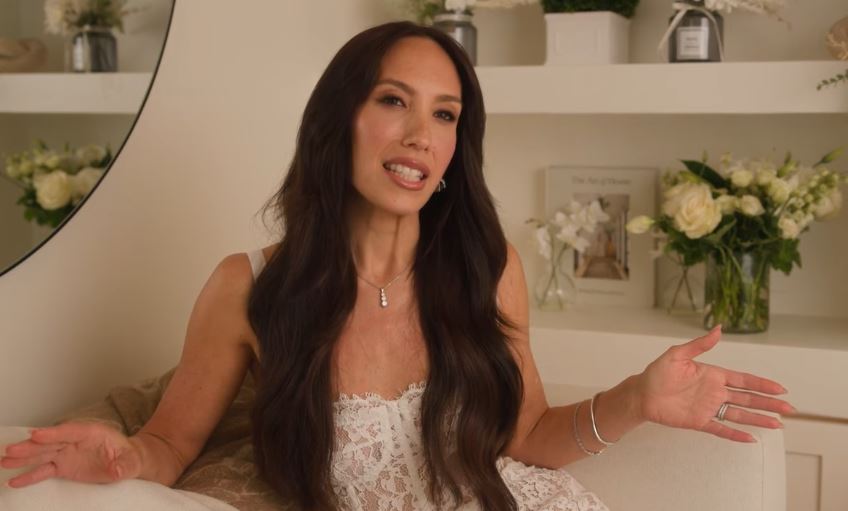
Credit: Us Weekly
Regarding her recent metamorphosis, Cheryl Burke has been remarkably open. She stated unequivocally that she is well. She did not have a face-altering operation, nor is she covertly recuperating from a secret illness. “I’m not sick,” she said candidly in a direct address to her fans, addressing the rumors. I didn’t receive a brow lift or a face transplant.
After weeks of conjecture, she made her remarks. Her return as a guest judge on Dancing with the Stars sparked a flurry of online discussion. Her softer facial features and noticeably slimmer body startled some fans. Cheryl’s response, however, was very clear: healing, not a hospital or a surgeon’s chair, was the source of her transformation.
| Label | Information |
|---|---|
| Name | Cheryl Burke |
| Born | May 3, 1984 — San Francisco, California |
| Occupation | Professional Dancer; Choreographer; Television Personality; Former Dancing with the Stars Pro |
| Career Highlights | Two-time Mirrorball Trophy winner; over 17 seasons on Dancing with the Stars; recurring television judge and podcast host |
| Recent Events | Returned as guest judge on DWTS Season 34 (October 2025); publicly addressed weight-loss and appearance rumors earlier in the year |
| Health and Wellness Notes | Lost approximately 30–35 lbs through lifestyle changes; denies using Ozempic or undergoing surgery; acknowledges minimal Botox use |
She revealed that she lost between thirty and thirty-five pounds by leading a consistent, mindful life rather than using quick fixes or injections. She made a commitment to movement, concentrated on eating clean, and started intermittent fasting. It had nothing to do with vanity. It had to do with equilibrium. Her nutrient-dense, moderate diet served as the basis for her newfound strength.
It’s interesting to note that Cheryl claimed the transformation was spiritual as well as emotional. She had to reassess her priorities following years of public scrutiny, dance injuries, and personal changes. Peace, self-care, and sobriety were more important than rivalry. She’s “starting from within,” as she puts it, and ultimately deciding to accept herself rather than strive for perfection.
Nevertheless, the response on social media was quick and occasionally harsh. Timelines were overflowing with pictures of Cheryl’s “before” and “after” states. She was accused of using Ozempic, a drug now frequently linked to celebrity weight loss, covertly. Others made surgical conjectures based on her sharper jawline and smoother skin. The remarks got out of control.
Rather than backing off, Cheryl confronted the sound. She emphasized her genuineness in the videos and captions she shared. She acknowledged using Botox, but she denied having face lifts, fillers, or surgery. She explained that the most significant change was the mask she wore, both literally and figuratively. The contouring makeup, heavy spray tans, and fake glow were all gone. She claimed that fans could now see her true self, her true face, and her true skin.
That was a very strong statement. It showed ownership rather than defensiveness—a woman taking back her identity after years of being boxed in and scrutinized in front of the spotlight. Cheryl’s look wasn’t wholly her own for seventeen seasons. A “look”—bronzed skin, oversized glam, and sculpted perfection—was required for ballroom competition. She has now calmly and confidently shed those layers.
Many women, especially those navigating their forties with poise and pressure, found resonance in this decision. Amidst a culture still fixated on youth and illusion, Cheryl’s readiness to age according to her own terms feels incredibly refreshing. The main takeaway from her message is that beauty and health can change over time.
It’s simple to understand how miscommunication developed. Curiosity rises when a public figure undergoes significant change. People believe there must be a problem. However, change frequently indicates growth rather than illness. One such instance is Cheryl’s metamorphosis. It’s a victory rather than a tragedy.
She broke the myth that a woman’s changing face or figure must be explained away by illness or surgery by speaking bluntly. Rather, she substituted introspection for gossip. She explained a healing process that many people could identify with: discovering how to love oneself in spite of outside definitions.
She has also been open about body dysmorphia and the long-term consequences of early career criticism. Hearing that she wasn’t “fit enough” or “thin enough” for years led to an exhausting internal dialogue. She is altering that voice today. She no longer travels with a scale or weighs herself compulsively. Rather than measuring, she emphasizes movement and nourishment. She claimed that the change has had a remarkable positive impact on her mental health.
Her story highlights a bigger problem: social media can easily skew empathy. Online audiences frequently transform curiosity into cruelty rather than celebrating transformation. A cultural tendency is highlighted by Cheryl’s experience: treating public figures like riddles that need to be solved, even at their expense.
Nevertheless, Cheryl’s composure has been remarkable amidst that turmoil. She still chooses patience over annoyance when interacting with her fans. Her voice is still upbeat. She challenges people to stop analyzing women’s faces as though they were property and to reevaluate what “healthy” actually means. Because it moves the emphasis from aesthetics to emotional sustainability, her viewpoint is especially novel.
Others in the entertainment sector have also been motivated by her experience to talk about body image more candidly. There is a noticeable ripple effect. Burke and other public figures soften the conversation for those who might be struggling in silence by compassionately stating the facts.
In a professional sense, her return to Dancing with the Stars is a reclamation rather than a mere comeback. Her expertise, poise, and compassion enhance the panel of judges. Viewers saw a woman boldly writing her next chapter rather than attempting to relive the past. Her attitude now exudes the same self-assurance that she once displayed through her movements.
Her tenacity has a powerfully persuasive quality. Anyone who has ever felt condemned for evolving, changing, or just being human can relate to it. The message of Cheryl Burke serves as a reminder that peace is more important than the mere absence of disease.

